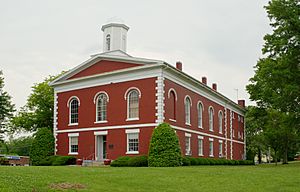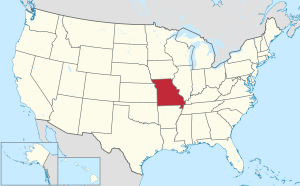Iron County, Missouri facts for kids
Quick facts for kids
Iron County
|
|
|---|---|

County courthouse in Ironton
|
|

Location within the U.S. state of Missouri
|
|
 Missouri's location within the U.S. |
|
| Country | |
| State | |
| Founded | February 17, 1857 |
| Named for | Iron ore |
| Seat | Ironton |
| Largest city | Ironton |
| Area | |
| • Total | 552 sq mi (1,430 km2) |
| • Land | 550 sq mi (1,400 km2) |
| • Water | 1.8 sq mi (5 km2) 0.3% |
| Population
(2020)
|
|
| • Total | 9,537 |
| • Density | 17.277/sq mi (6.671/km2) |
| Time zone | UTC−6 (Central) |
| • Summer (DST) | UTC−5 (CDT) |
| Congressional district | 8th |
Iron County is a county located in the Lead Belt region in the U.S. state of Missouri. As of the 2020 census, the population was 9,537. The largest city and county seat is Ironton. Iron County was officially organized on February 17, 1857, and was named after the abundance of iron ore found within its borders.
Iron County includes the 6-mile (9.7 km)-long, 2-mile (3.2 km)-wide Arcadia Valley, the site of Pilot Knob, Ironton, and Arcadia, communities established by immigrants in the 19th Century. The valley is surrounded by the Saint Francois Mountains of the Ozarks Plateau. Iron County is also home to dozens of mountains, including the 1,772-foot (540 m) Taum Sauk Mountain, the highest point in Missouri.
The county is home to a number of state parks and historical sites including Taum Sauk Mountain State Park, Elephant Rocks State Park and Fort Davidson State Historic Site as well as 96,047 acres (390 km2) of Mark Twain National Forest.
Contents
Geography
According to the U.S. Census Bureau, the county has a total area of 552 square miles (1,430 km2), of which 550 square miles (1,400 km2) is land and 1.8 square miles (4.7 km2) (0.3%) is water.
Adjacent counties
- Washington County (north)
- St. Francois County (northeast)
- Madison County (east)
- Wayne County (southeast)
- Reynolds County (southwest)
- Dent County (west)
- Crawford County (northwest)
National protected areas
- Mark Twain National Forest (part)
- Pilot Knob National Wildlife Refuge
Demographics
| Historical population | |||
|---|---|---|---|
| Census | Pop. | %± | |
| 1860 | 5,842 | — | |
| 1870 | 6,278 | 7.5% | |
| 1880 | 8,183 | 30.3% | |
| 1890 | 9,119 | 11.4% | |
| 1900 | 8,716 | −4.4% | |
| 1910 | 8,563 | −1.8% | |
| 1920 | 9,458 | 10.5% | |
| 1930 | 9,642 | 1.9% | |
| 1940 | 10,440 | 8.3% | |
| 1950 | 9,458 | −9.4% | |
| 1960 | 8,041 | −15.0% | |
| 1970 | 9,529 | 18.5% | |
| 1980 | 11,084 | 16.3% | |
| 1990 | 10,726 | −3.2% | |
| 2000 | 10,697 | −0.3% | |
| 2010 | 10,630 | −0.6% | |
| 2020 | 9,537 | −10.3% | |
| U.S. Decennial Census 1790-1960 1900-1990 1990-2000 2010-2015 2020 |
|||
As of the census of 2000, there were 10,697 people, 4,197 households, and 2,963 families residing in the county. The population density was 7/km2 (18/sq mi). There were 4,907 housing units at an average density of 3/km2 (7.8/sq mi). The racial makeup of the county was 96.74% White, 1.56% Black or African American, 0.34% Native American, 0.09% Asian, 0.22% from other races, and 1.05% from two or more races. Approximately 0.58% of the population were Hispanic or Latino of any race.
There were 4,197 households, out of which 32.00% had children under the age of 18 living with them, 56.80% were married couples living together, 9.40% had a female householder with no husband present, and 29.40% were non-families. 25.80% of all households were made up of individuals, and 11.40% had someone living alone who was 65 years of age or older. The average household size was 2.46 and the average family size was 2.94.
In the county, the population was spread out, with 25.00% under the age of 18, 7.80% from 18 to 24, 25.30% from 25 to 44, 24.80% from 45 to 64, and 17.10% who were 65 years of age or older. The median age was 40 years. For every 100 females there were 94.80 males. For every 100 females age 18 and over, there were 90.80 males.
The median income for a household in the county was $31,276, and the median income for a family was $38,037. Males had a median income of $28,603 versus $16,615 for females. The per capita income for the county was $16,717. About 13.80% of families and 19.00% of the population were below the poverty line, including 27.60% of those under age 18 and 13.20% of those age 65 or over.
Religion
According to the Association of Religion Data Archives County Membership Report (2000), Iron County is a part of the Bible Belt with evangelical Protestantism being the majority religion. The most predominant denominations among residents in Iron County who adhere to a religion are Southern Baptists (56.62%), Methodists (10.60%), and Roman Catholics (7.82%).
2020 census
| Race | Num. | Perc. |
|---|---|---|
| White (NH) | 8,602 | 90.2% |
| Black or African American (NH) | 136 | 1.43% |
| Native American (NH) | 60 | 0.63% |
| Asian (NH) | 34 | 0.36% |
| Pacific Islander (NH) | 2 | 0.02% |
| Other/Mixed (NH) | 526 | 5.52% |
| Hispanic or Latino | 177 | 1.9% |
Education
Of adults 25 years of age and older in Iron County, 65.2% possesses a high school diploma or higher while 8.4% holds a bachelor's degree or higher as their highest educational attainment.
Public schools
- Arcadia Valley School District - Ironton
- Arcadia Valley Elementary School (PK-04)
- Arcadia Valley Middle School (05-08)
- Arcadia Valley High School (09-12)
- Belleview R-III Elementary School - Belleview - (K-08)
- Iron County C-4 School District - Viburnum
- Viburnum Elementary School (K-06)
- Viburnum High School (07-12)
- South Iron County R-I School District - Annapolis
- South Iron County Elementary School (PK-06)
- South Iron County High School (07-12)
Vocational/technical schools
- Arcadia Valley Career Technical Center - Ironton - (09-12)
Public libraries
- Ozark Regional Library
Transportation
State highways
Railroads
- The Iron Mountain Railroad, later incorporated into Union Pacific, runs through Arcadia Valley. The train station in Arcadia serves Amtrak's Texas Eagle.
Communities
Cities and Towns
Unincorporated Communities
See also
 In Spanish: Condado de Iron (Misuri) para niños
In Spanish: Condado de Iron (Misuri) para niños

